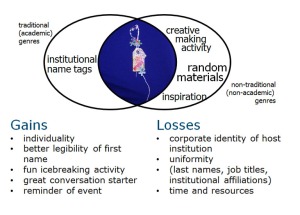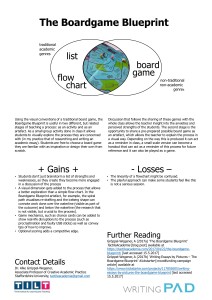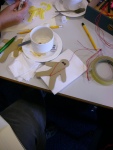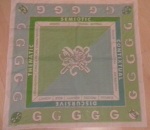Sharing ReGenring – with a little help from my template
Here the first follow-up post promised in my write up of the #ReGenring17 conference.
For the afternoon we had scheduled a ‘Sharing Session’ – essentially some time for people to just talk to each other. In order to give some broader starting points than just the keynotes, I had put out a Call for Practice as a first announcement of the conference, and quite a few people had responded to that.
The idea was that people would pick an example of their genring practice to show off, so that delegates could have a look at this. I had decided to give a structure to this by asking the sharers to fill in a very basic questionnaire about their projects to send to me the week previously, which I then fitted into a basic template. So everybody who shared their work had a poster that was following the same format.
One of the feedback comments stated
The posters are informative but all have the same format (template), Maybe delegates could present their work/research in chosen individual ways?
Let me explain that decision… I decided on using a template on purpose, for a number of reasons:
- This needed to work as a stand-alone piece of work, so even if the sharer didn’t bring any other artefacts or documents to show and wasn’t present (due to talking to somebody else at that time), this still needed to make sense. Current poster practice (see my recent blog post on this – told you it made sense to have it as an interlude before this post) shows that stand-alone posters often use what I call a ‘Spineless Report’ or ‘Box Set’ approach. I really didn’t want any of the former, because people get either bored by too much text or frustrated when not having the time to read it all. But a ‘Box Set’ like approach I thought was much better – ask the sharers about something specific.
- When everybody uses the same template what you end up with are posters that are much easier to compare.
- I wanted to steer the sharing session towards the process of genring and regenring, so the template was designed to prompt the sharers into that, rather than just show off the fabulous outcomes that they achieved.
- And I was also already thinking of the special edition of the Journal of Writing in Creative Practice that we are putting together on the back of this. For that we had been talking about a section that shows off examples, like a catalogue in a way, so I actually designed a format with that in mind. I think I can pull the posters into spreads for the journal pretty easily to achieve this catalogue section, making little extra work for the sharers. So it is a multi-genre performing template.
In short, while choosing a template format for the sharing session loses the individuality of expression from the sharers, it gains the easier comparability. As sharers were encouraged to bring extra materials, the format of which they were free to choose themselves, I think they had the opportunity to still customise what they were showing sufficiently.
So why this template?
I have designed and worked with a template/format that looks at genre before: the Dress-Up Doll of Formality. In a nutshell this is an activity I designed for my students to become more aware of the ‘rules’ of a genre, by likening writing for a specific audience to dressing for a specific occassion. So what I ask them to do is to design an outfit for a Gingerbreadperson that is like a genre they explore (tweet, academic essay, billboard poster, etc.) and then also add why they chose this outfit. It gets the students to pay attention to the rules in a visual and fun way (and I have also run this as a workshop for staff and management, which can be much fun). This works fine in the context it was designed for, but seemed too simple in the context of this conference. And, of course, it puts the focus on the established rules of one genre, but not on the process of genring or regenring.
Of course there is a theoretical framework custom-made for this, Fiona English’s work, which looks at genre in the context of two orientations, the social and the material, breaking these down further into contextual and discursive as well as thematic and semiotic aspects respectively, to then break these down even further. This one seemed at the other end of the spectrum, a bit too complex. I didn’t want to scare the potential sharers away by sending them a template that basically meant they would first have to read a chapter or book in order to understand it.
So I needed to find a middle ground. Fairly simple to break down, but giving pertinent information. And it needed a simple visual as well, something that could be customised to show a flavour of the individual projects, but still somewhat uniform. And it needed to make sense as a visual metaphor for the process of genring and regenring.
I decided to ask people to focus on the gains and losses that the ‘new’ genre has opposed to the ‘old’ genres it is inspired by or based on. I thought that was probably the most crucial concept, information that people new to genring would need (or want to have) when considering their own projects for the future. And I stumbled across the Venn Diagram as a visual that shows the idea of two different ‘pools’ of genre that overlap – and this overlap is what we are interested in.

template example from Welcome Presentation discussing the outcomes of the Make-Your-Own-Nametag activity
So we first identify the genres the ‘new’ genre is based on. In our context this is often a traditional academic genre (which I put on the left) and a non-academic genre (which I put on the right) – although of course in a different context these might not be linked to academic genres at all, or could all be academic genres. The ‘new’, or featured, genre is in the middle – an ideal place to put an image giving a sense of an example of that genre. And then it is simply a matter of identifying the gains and losses of that genre in the overlap. Of course you ‘lose’ and ‘gain’ things from both sides of the Venn Diagram. For this exercise it is important to try and list all the gains and losses; identifying losses in particular is hard, because usually these are things you are happy to lose, otherwise you wouldn’t decide to try this new genre. But listing it all is really helpful in allowing you to make an informed decision.
I think this template might actually become a simple way to familiarise people with the concept of genring and would also work as an activity sheet to think through potential gains and losses when switching from one genre to the next, so I also made them as a handout with simple instructions that you can download here (including the space we had on the poster for a description of the new genre): Genring Handout blank




Reblogged this on Becoming An Educationalist and commented:
#becomingeducational Gets all #reGenring17
The power of reGenring was explored and celebrated at #reGenring17 – NTU this June.
It was a fabulous day – full of excitement, fun and laughter – not something you can always say about an academic conference!
This post looks at the power of reGenring – and the way that ALke structured this with her Poster Template…
What reGenring so you do?
Pingback: Call for Papers for Genring and Regenring Special Issue | Tactile Academia